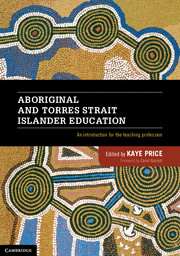Book contents
- Frontmatter
- Contents
- Contributors
- Acknowledgements
- Chapter 1 A brief history of Aboriginal and Torres Strait Islander education in Australia
- Chapter 2 The Stolen Generations
- Chapter 3 Delivering the promise
- Chapter 4 Your professional experience and becoming professional about working with Aboriginal and Torres Strait Islander students and communities
- Chapter 5 The ‘silent apartheid’ as the practioner’s blindspot
- Chapter 6 Better
- Chapter 7 Maths as storytelling
- Chapter 8 Information and communication technologies in the classroom
- Chapter 9 Language and literacy
- Chapter 10 Aboriginal and Torres Strait Islander Studies in the classroom
- Chapter 11 Engaging Indigenous students
- Appendix A Take a book: Any book
- Appendix B1 Terminology
- Index
- References
Chapter 9 - Language and literacy
- Frontmatter
- Contents
- Contributors
- Acknowledgements
- Chapter 1 A brief history of Aboriginal and Torres Strait Islander education in Australia
- Chapter 2 The Stolen Generations
- Chapter 3 Delivering the promise
- Chapter 4 Your professional experience and becoming professional about working with Aboriginal and Torres Strait Islander students and communities
- Chapter 5 The ‘silent apartheid’ as the practioner’s blindspot
- Chapter 6 Better
- Chapter 7 Maths as storytelling
- Chapter 8 Information and communication technologies in the classroom
- Chapter 9 Language and literacy
- Chapter 10 Aboriginal and Torres Strait Islander Studies in the classroom
- Chapter 11 Engaging Indigenous students
- Appendix A Take a book: Any book
- Appendix B1 Terminology
- Index
- References
Summary
My mother, my daughter and I are all Ngarigu women. We are matrilineal, tracing our family through the women for as long as we have been a people. Our country is in south-east Australia and is now known widely as the Snowy Mountains, the High Country of south-eastern New South Wales and northern Victoria. We know our country and stories of our family in that country for countless generations. However, when we talk about business to do with our family it is always in English because, for most of the people who identify as Ngarigu, with the exception of a few old people, our language is sleeping – it is not the language in which we still communicate. We talk about our languages as being ‘asleep’, waiting for us to wake them up again, because while ever the people who belong to a language still exist, that language continues to have a life. We need the teachers of Australia to work with us to help us wake up our languages.
Because of the devastating effects of colonisation on blackfellas in this country – through disease, murder and other forms of attempted genocide over the past 200 years – our language and culture has taken on a different shape and form. … [T]his undoubtedly affects the transmission and retention of our language and culture. While it has not survived intact, but in varying states and degrees of healthiness, it has survived. Many of us are working with what remains in determined efforts to rebuild ourselves and our families and communities back to a point where we are no longer just victims of a system that set out to destroy us as a race.
(Bell, 2002, pp. 46–7).Teaching an Australian language to your students helps develop their self esteem, engagement with education and their overall well being. There are no better reasons for teaching a subject. As Jeanie Bell so powerfully put it, our languages are a key to maintaining and preserving ourselves as Aboriginal and Torres Strait Islander peoples. Schools have an important role in working with us to maintain and revitalise our languages.
- Type
- Chapter
- Information
- Aboriginal and Torres Strait Islander EducationAn Introduction for the Teaching Profession, pp. 131 - 150Publisher: Cambridge University PressPrint publication year: 2012



